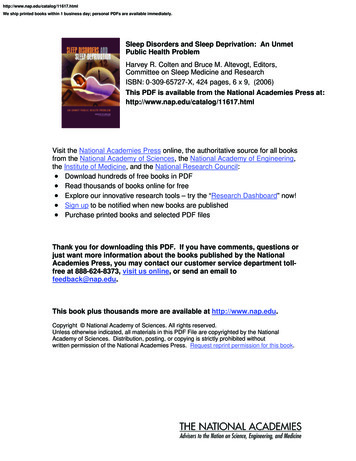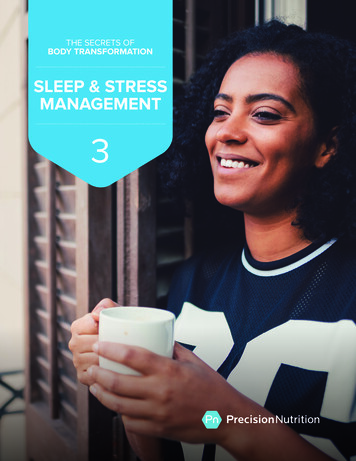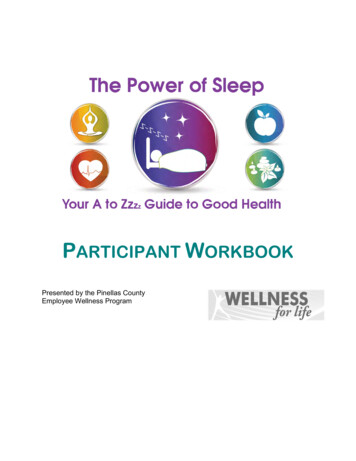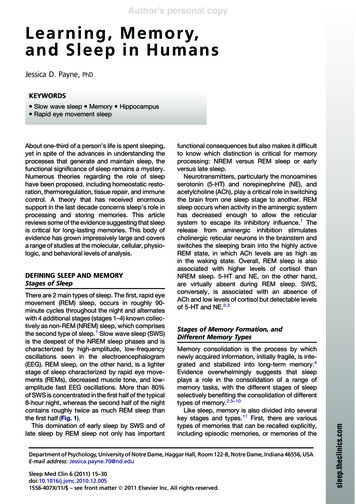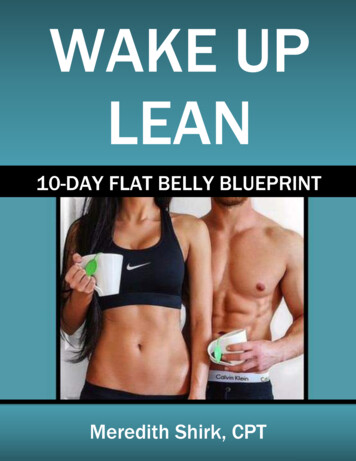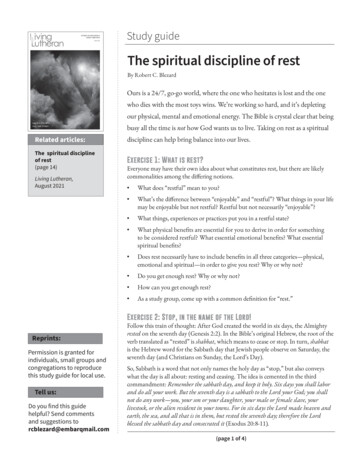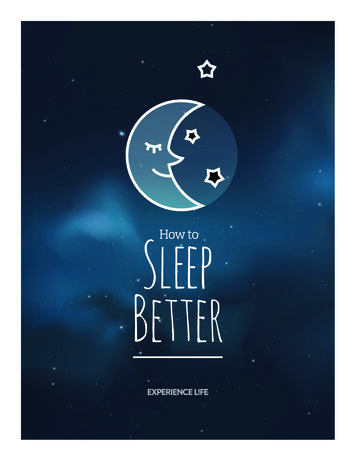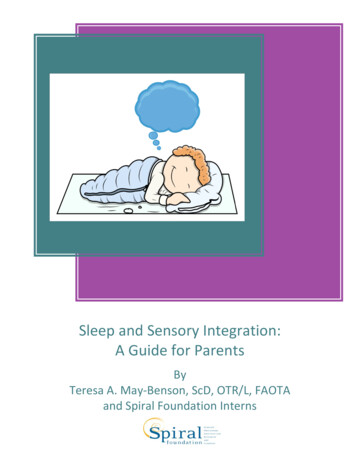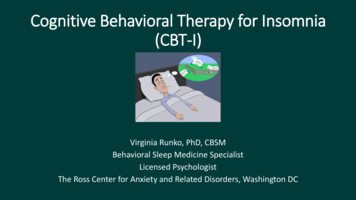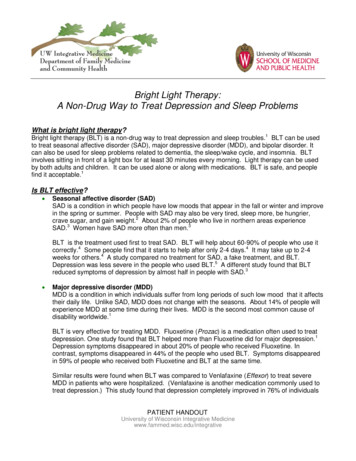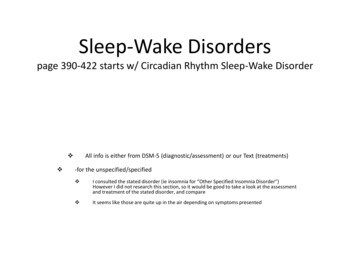
Transcription
Sleep-Wake Disorderspage 390-422 starts w/ Circadian Rhythm Sleep-Wake Disorder All info is either from DSM-5 (diagnostic/assessment) or our Text (treatments)-for the unspecified/specified I consulted the stated disorder (ie insomnia for “Other Specified Insomnia Disorder”)However I did not research this section, so it would be good to take a look at the assessmentand treatment of the stated disorder, and compare It seems like those are quite up in the air depending on symptoms presented
Sleep Wake DisordersBreathing Related Sleep DisordersDisorderCodes SubtypesAssessmentTreatmentCircadian RhythmSleep-WakeDisordersCode: 307.45 Delayed sleep phase typeG47.21 Advanced sleep phasetype G47.22 Irregular Sleep-Waketype G47.23 Non-24-hour sleep-waketype G47.24 Shift Work type G47.26 Unspecified type G47.20 Sleep Diary Actigraphy (wristsleep/wake detector) Diagnosis UnclearBiomarkers (Salivary dimlight melatonin onset) Sequential Measurementof phase markers(melatonin) (primarily for Sleep log associated withchronobiology (resettingdaily life schedule)(DSM-5 pp. 391-8)Non-24 hour sleep-waketype) Behavior modificationTechniques Interventions:psychoeducation, lighttherapy (increasingmelatonin), restrictions onalcohol/caffeine, sleephygiene rules(Kress & Paylo, 2015, p. 504)
Sleep Wake ntNon-Rapid EyeMovement SleepArousal Disorders Sleepwalking type 307.46(F51.3) Sleep Terror type 307.6 (F51.4) Polysomnography andaudiovisual monitoring todocument episodes Children-family therapy,increased emotionalconnectionNightmare Disorder 307.47 (F51.5) Polysomnography Cognitive Behavioral TherapyInterventionsImage Rehearsal Therapy, Luciddreaming therapy, Exposure,Relaxation and RescriptingTherapy (EERT)Rapid Eye MovementSleep BehaviorDisorder 327.42 (G47.52) Medical evaluationPolysomnography Medications (melatonin,clonazepam)Restless LegsSyndrome 333.94 (G25.81) Self-Report, History ofepisodes, ImmobilizationTest, serum ferritin leveltest (iron in body),Polysomnography For mild case: Self-directedactivities during onset ofsensation (read, stretch,massage) For Severe case: medication(low-dose dopamine agonists)Last resort: Anticonvulsants,Opiods Adults Interventions: reducedeep sleep throughmedication, behavior changes,counseling to consider options(Kress & Paylo, 2015, pp. 505-6)
Sleep Wake reatmentSubstance/MedicationInduced Sleep Disorder Medical evaluation/ consultation,Electroencephalographic sleep profile,All night Polysomnography, MultipleSleep Latency Test, 2 Week SleepDiary, Actigraphy, Drug Screening Consult with medical doctor,psychiatristOther Specified InsomniaDisorder Polysomnography, Quantitativeelectroencephalographic analysis Cognitive Behavioral Therapy,Behavioral therapy Psychoeducation, sleep hygienerules, relaxation techniques, sleeprestrictions, cognitive techniquesUnspecified InsomniaDisorder Polysomnography, Quantitativeelectroencephalographic analysis Cognitive Behavioral Therapy,Behavioral therapy Psychoeducation, sleep hygienerules, relaxation techniques, sleeprestrictions, cognitive techniquesOther SpecifiedHypersomnolence Disorder Medical evaluation/ consultation,Multiple sleep latency test,Nocturnal polysomnography Cognitive Behavioral Therapy,Behavior therapy,psychopharmacotherapy Cognitive Behavioral Therapy,Behavioral therapy Psychoeducation, sleep hygienerules, relaxation techniques, sleeprestrictions, cognitive techniques
Sleep Wake reatmentUnspecifiedHypersomnolence Disorder Medical evaluation/ consultation,Multiple sleep latency test,Nocturnal polysomnography Cognitive Behavioral Therapy,Behavior therapy,psychopharmacotherapyOther Specified SleepWake Disorder Medical evaluation/ consultation,Biological validators,PolysomographyTreatment Depends on presentingsymptoms Cognitive Behavioral Therapy,Behavioral therapy, medications,oral applications, ventilators Psychoeducation, sleep hygienerules, relaxation techniques, sleeprestrictions, cognitive techniquesUnspecified Sleep-WakeDisorder Medical evaluation/ consultation,Biological validators,PolysomographyTreatment Depends on presentingsymptoms Cognitive Behavioral Therapy,Behavioral therapy, medications,oral applications, ventilators Psychoeducation, sleep hygienerules, relaxation techniques, sleeprestrictions, cognitive techniques(Kress & Paylo, 2015, pp. 361-73)
Sleep-Wake Disorders: Diagnostic Criteria: Circadian Rhythm Sleep-Wake DisordersCircadianRhythm SleepWake Disorders1. Delayed SleepPhase Type2. Advanced SleepPhase Type3. Irregular SleepWake Type4. Non-24 HourSleep-Wake Type5. Shift WorkType(DSM-5 pp.391-8)Code: 307.45 (G47.21)Code: 307.45 (G47.22)Code: 307.45 (G47.23)Code: 307.45 (G47.24)Code: 307.45(G47.26) Recurrent Patternof Sleep disruption History of delay in timing ofmajor sleep pd.(usually 2 hrs.)compared to desired sleep/wake Sleep-wake times several hoursearlier than desired history of insomnia at night Pattern of sleep-wake cyclesnot synchronized to 24 hr.environment Excessivesleepiness,insomnia, or both based on history ofindividual working outof 8AM-6PM daylightschedule on a regularbasis Causes distress orimpairment insocialoccupational, &other functioning Lasts 3 monthstime History of advance in timing ofmajor sleep pd. (usually 2 hrs.)compared to desired sleep/waketime Difficulty waking in themorning (morning confusion) Early morning insomnia Excessive early day sleepiness Excessive daytime sleepinessCommon features history of mentaldisorder/concurrent mentaldisorder ”morning types” biomarkersoccur 2-4 hr. earlier than normal Psychophysiological insomniaDifferential Diagnosis:Normative variations in SleepOther Sleep Disorders use of drugs to combat sleepwake time may lead to substanceabuse Onset late adulthood Familial Symptom severity increaseswith age varies according to lifestyle andlifespan excessive sleepiness/nappingin the day No major sleep pd. Fragmented sleep into atleast 3 pds. in 24 hrs. Commonly linked toneurodegenerative disorders(major neurocognitivedisorder, neurodevelopmentaldisorders) Linked to limitedenvironmental light exposureDifferential Diagnosis:Normative variations in sleepOther medical conditions andmental disorders Consistent daily drift ofsleep-wake times. Common among the visuallyimpaired (50% prevalence) Insomnia during majorsleep pd.and/ or Excessive sleepinessduring major awake pd.associated with a shiftwork schedule In sighted individuals oftendue to lack of light andstructured activity May effect travelersfrequently flying acrosstime zones Associated with traumaticbrain injury May effect those withrotating shiftsDifferential Diagnosis:Circadian Rhythm Sleep-WakeDisorders Common in 50 pds of insomnia, excessivesleepiness or both alteringwith asymptomatic pds.Depressive DisordersDifferential Diagnosis:Other Sleep DisordersDepressive and BipolarDisordersDifferential Diagnosis:Normative Variations inSleep with Shift WorkR/O:Other Sleep Disorders
Sleep-Wake Disorders: Diagnostic Criteria: ParasomniasParasomnias(DSM-5 pp. 399422)Non-Rapid EyeMovement (NREM)Sleep ArousalDisordersSleepwalking type Code:307.46(F51.3)Non-Rapid EyeMovement (NREM)Sleep ArousalDisorders Most commonNREM SleepBehavior DisorderREM SleepBehavior Disorder No or little dream imagery(single scene)Differential Diagnosis:Nightmare Disorder Amnesia for episodeBreathing-Related SleepDisorders eyes are typically open Significant stress andimpairment of functioningSleep Terrors Repeated occurrence of suddenawakening from sleep Often begins w/ scream/cry Automatic arousal Intense fear, compulsion toescape Automatic arousal (rapidbreathing, sweating, etc.) Unresponsiveness to othersefforts to comfortCode: 307.47(F51.5)Rapid EyeMovement (REM)Sleep BehaviorDisorderRestless LegSyndromeCode: 333.94(G25.81)Code: 327.42(G47.52)(Continued) Repeated occurrence ofincomplete arousals can be briefup to 10 mins. or up to 1 hr. infirst 3rd of sleeping episodeSleepwalking repeated episodes of complexmotor behavior initiated duringsleep Episodes begin during NREM reduced alertness blank stare unresponsive tocommunication limited recall afterward initial confusion immediatelyfollowing return to full cognitivefunction afterwardsNightmareDisorder(Continued)Sleep terror typeCode: 307.46 (F51.4) Abnormalbehavioral,experiential orphysiologicaleventsoccurring n-Rapid EyeMovement(NREM)Sleep ArousalDisorders Not due to drug use/Medication Mental and Medical disordersdo not explain episodesSleep Related Eating Disorder eating w/ amnesia rangingfrom no-full awarenessSleep Related sexual behavior(sexsomnia) Arising from sleep andparticipating in sexual activityw/ no conscious awarenessREM Sleep BehaviorDisorderParasomnia OverlapSyndromeSleep-Related SeizuresAlcohol-InducedBlackoutsDissociative Amnesia, w/Dissociative FugueMalingering or othervoluntary behavioroccuring duringwakefulnessCommon in children link w/ major depressiveepisodes and obsessivecompulsive disorderMedication-InducedComplex Behaviors Repeated occurrences ofdream imagery involvingextreme negative emotions well remembered Alert after dream episode Significant distress orimpairment in functioning Repeated episodes ofarousal during sleepReplicative Nightmares-occur after a traumaticexperience Motor behaviors can beviolentDifferential Diagnosis:Sleep Terror DisorderREM Sleep behaviorDisorderBereavement Vocal and/or complexmotor behaviors inresponse to threats “dreamenacting behaviors” Happen in REM sleep(90 mins into sleep onset) Awaken alert and NOTconfused/disoriented Causes significantdistress and/or impairmentof functioningNarcolepsyNocturnal Seizures Present in 30% ofnarcolepticsBreathing-Related SleepDisordersDifferential Diagnosis:Other ParasomniasPanic DisorderNocturnal SeizuresSleep-Related DissociativeDisordersObstructive Sleep ApneaNight Eating SyndromeMedication or SubstanceAbuseOther SpecifiedDissociative DisorderMalingering desire to move the legs orarms due to uncomfortablefeelings Urge to move-worsens during rest-is relieved bymovement-worse in evening 3x/week At least 3 months Causes significantdistress and/or impairmentof functioningDifferential Diagnosis:Substance Intoxication orwithdrawalDeliriumOther Sleep DisordersSleep Disorder due toanother medical condition
Sleep-Wake Disorders: Diagnostic Criteria: ParasomniasSubstance/MedicationInduced SleepDisorder(DSM-5 pp s(292.85)4. Opiods(292.85)5. Sedative,hypnotic, oranxiolytic(292.85)6.Amphetamine(or otherstimulant)(292.85)7. Tobacco(292.85)8. Other (orunknown)Substance(292.5) often occurswith insomniatype producesinsomnia may shortensleep latency-Increase insleepiness andsleep depth Similar toOpiods Insomnia duringintoxication Insomnia signs ofwithdrawal daytimesleepiness enhances slowwave sleep /sleepinducing Increasessleepiness ExcessiveSleepiness duringwithdrawal Medicationsaffectingcentral. and/orautomaticnervoussystems maycause sleepdisturbancesCode: 780.52 (G47.00)Prominent/severedisturbance in sleep-develop during/afterintoxication or-after withdrawaland-Substance is capable ofsleep disturbance Sleep disorders are ruledout does not occur duringdelirium Symptoms causesignificant distressorImpairment of functioningDifferential Diagnosis:Substance intoxication orwithdrawalDelirium Extremelydisrupted sleepFirst half of night Immediate/short livedsedative effect increasedintensity of REMsleep (vividdreams- alcoholwithdrawaldelirium)Second half ofnight Restlessness can aggravatebreathing-relatedsleep disorderOther Sleep DisordersSleep Disorder due toanother medical condition fragmentedsleep can last forweeks/years inchronic alcoholusers Chronic usersdeveloptolerance to sleepeffects Withdrawalsigns sleepdifficulties andunpleasantdreams-may last forweeks-W/ chronic usetolerancedevelops andinsomnia-Respiratorydepressant effectsworsen sleepapnea Decreaseswakefulness W/ chronic usetolerance developsand insomnia Daytimesleepiness MDMA-restlessness anddisturbed sleepwithin 48hrs.-frequent use isconnected withanxiety, depression,steep disturbanceseven during pds. ofnon use Decreased slowwave sleep Reduction ofsleep efficiency Increaseddaytimesleepiness Withdrawal-impaired sleep Heavy smokersmay awake atnight due tocravings
Sleep-Wake Disorders: Diagnostic Criteria: ParasomniasOther SpecifiedInsomnia DisorderUnspecifiedInsomnia DisorderCode: 780.52(G47.09)Code: 780.52 (G47.00)Other mnolenceDisorderCode: 780.54 (G47.19)Code: 780.54 (G47.10)Code: 780.59 (G47.8) Does not meet fulldiagnostic criteria for sleepwake/other specifiedinsomnia/ other specifiedhypersomnolence disorders Does not meet fulldiagnostic criteria for sleepwake/other specifiedinsomnia/ other specifiedhypersomnolence disorders Used when clinicianCHOOSES TO SPECIFYreason why criteria is notmet for sleep-wake/otherspecified insomnia/ otherspecified hypersomnolencedisorders Used when a clinicianCHOOSES NOT TOSPECIFY a reason criteriaare not met for sleepwake/other specifiedinsomnia/ other specifiedhypersomnolence disorders Sleep-Wake Disordersymptoms cause significantdistressorImpairment of functioning Sleep-Wake Disordersymptoms cause significantdistressorImpairment of functioning Does not meet fulldiagnostic criteria forInsomnia/sleep-wakedisorders Does not meet fulldiagnostic criteria forHypersomnolence/sleepwake disorders Does not meet fulldiagnostic criteria forHypersomnolence/sleepwake disorders Used when clinicianCHOOSES TO SPECIFYreason why criteria is notmet for insomnia/sleep-wakedisorders Used when a clinicianCHOOSES NOT TOSPECIFY a reason criteriaare not met forinsomnia/sleep-wakedisorders Used when clinicianCHOOSES TO SPECIFYreason why criteria is notmet for hypersomnolence/sleep-wake disorders Used when a clinicianCHOOSES NOT TOSPECIFY a reason criteriaare not met forhypersomnolence/sleepwake disorders insomnia disordersymptoms cause significantdistressorImpair areas of functioning Hypersomnolence disordersymptoms cause significantdistressorImpairment of functioning Hypersomnolence disordersymptoms cause significantdistressorImpairment of functioning(e.g., brief-durationhypersomnolence) Insufficient information tomake a more specificdiagnosis Brief Insomnia Disorder-pd. less than 3 mos. Restricted to nonrestorativesleep Insufficient information tomake a more specificdiagnosisUnspecified SleepWake DisorderCode: 780.59 (G47.9) Does not meet fulldiagnostic criteria forInsomnia/sleep-wakedisorders insomnia disordersymptoms cause significantdistressorImpair areas of functioningOther SpecifiedSleep-WakeDisorder Insufficient information tomake a more specificdiagnosis
Sleep-Wake Disorders Insomnia Disorder (DSM Pages 362-368)DiagnosisDiagnostic Criteria A predominant compliant of dissatisfaction with sleepquantity/quality, along with at least one of the following:1.Difficulty initiating sleep (In children, may be without caregiverintervention)2.Difficulty maintaining sleep due to frequent awakenings orproblems returning to sleep after reawakenings (In children, maybe difficulty returning to sleep without caregiver intervention)3.Early-morning reawakening with inability to return to sleep Causes clinically significant distress or impairment in functioning The sleep difficulty occurs at least 3 nights per week Is present for at least 3 months Occurs despite adequate opportunity for sleep Specify if:With non-sleep disorder mental comorbidity, includingsubstance use disordersWith other medical comorbidityWith other sleep disorder Specify if:Episodic: Symptoms last at least a month but less than 3monthsPersistent: Symptoms last 3 months or longerRecurrent: Two (or more) episodes within the space of a yearDifferential Diagnosis Normal sleep variations Situational/acute insomnia Delayed sleep phase and shift work types of circadian rhythmsleep-wake disorder Restless legs syndrome Breathing-related sleep disorders Narcolepsy Parasomnias Substance/medication-induced sleep disorder, insomnia type AssessmentTraditional clinicalinterview (Kress &Paylo, 2015)Referral to a sleepdisorder center or to asleep disorder specialistfor use of laboratoryexaminations (Kress &Paylo, 2015) TreatmentCBTBehavior Therapy(BT) pines
Hypersomnolence Disorder (DSM Pages 368-372)DiagnosisDiagnostic Criteria Self-reported excessive sleepiness despite a main sleep periodlasting at least 7 hours, with at least one of the following:1.Recurrent periods of sleep or lapses into sleep within the same day2.A prolonged main sleep episode of more than 9 hours per day thatis nonrestorative3.Difficulty being fully awake after abrupt awakening Occurs at least 3 times per week for at least 3 months Accompanied by significant distress or impairment in functioning Specify if:With non-sleep disorder mental comorbidity, includingsubstance use disordersWith medical conditionWith other sleep disorder Specify if:Acute: Duration of less than 1 monthSubacute: Duration of 1-3 monthsPersistent: Duration of more than 3 months Specify current severity:Mild: Difficulty maintaining daytime alertness 1-2days/weekModerate: Difficulty maintaining daytime alertness 3-4days/weekSevere: Difficulty maintaining daytime alertness 5-7 days/weekDifferential Diagnosis Normative variation in sleep Poor sleep quality and fatigue Breathing-related sleep disorders Circadian rhythm sleep-wake disorders Parasomnias Other mental disorders AssessmentTraditional clinicalinterview (Kress &Paylo, 2015)Referral to a sleepdisorder center or to asleep disorder specialistfor use of laboratoryexaminations (Kress &Paylo, 2015)Medical evaluation andconsultation (Kress &Paylo, 2015) mines)(Mazindol, Modafinil)Antidepressants
Narcolepsy (DSM Pages 372-378)DiagnosisDiagnostic Criteria Recurrent periods of an irrepressible need to sleep, lapsing into sleep, or napping occurring with the same day; occurring at least 3 times per week over the past 3 months Presence of at least one of the following:1.Episodes of cataplexy, defined as either (a) or (b), occurring at least a few times per month: a. In individuals with long-standing disease, brief (seconds to minutes) episodes of sudden bilateral loss of muscle tone with maintained consciousness that areprecipitated by laughter or jokingb. In children or in individuals within 6 months of onset, spontaneous grimaces or jaw-opening episodes with tongue thrusting or a global hypotonia, without anyobvious emotional triggers1.Hypocretin deficiency, as measured using cerebrospinal fluid (CSF) hypocretin-1 immunoreactivity values (less than or equal to one-third of values obtained in healthy subjects testedusing the same assay, or les than or equal to 110 pg/mL) not observed in the context of acute brain injury, inflammation, or infection2.Nocturnal sleep polysomnography showing rapid eye movement (REM) sleep latency less than or equal to 15 minutes, or a multiple sleep latency test showing a mean sleep latency lessthan or equal to 8 minutes and tow or more sleep-onset REM periods Specify whether:347.00 Narcolepsy without cataplexy but with hypocretin deficiency: Criterion B requirements of low CSF hypocretin-1 levels and positive polysomnography/multiple sleep latencytest are met, but no cataplexy is present (Criterion B1 not met)347.01 Narcolepsy with cataplexy but without hypocretin deficiency: In this rare subtype (less than 5 % of narcolepsy cases), Criterion B requirements of cataplexy and positivepolysomnography/multiple sleep latency test are met, but CSF hypocretin-1 levels are normal (Criterion B2 not met)347.00 Autosomal dominant cerebellar ataxia, deafness, and narcolepsy: This subtype is caused by exon 21 DNA (cystosine-5)-methyltransferase-1 mutations and is characterized bylate-onset (age30-40 years) narcolepsy (with low or intermediate CSF hypocretin-1 levels), deafness, cerebellar ataxia, and eventually dementia347.00 Autosomal dominant narcolepsy, obesity, and type 2 diabetes: Narcolepsy, obesity, and type 2 diabetes and low CSF hypcretin-1 levels have been described in rare cases andare associated with a mutation in the myelin oligodendrocyte glycoprotein gene347.10 Narcolepsy secondary to another medical condition: This subtype is for narcolepsy that develops secondary to medical conditions that cause infectious (e.g., Whipple’sdisease, sarcoidosis), traumatic, or tumoral destruction of hypocretin nuerons Specify current severity:Mild: Infrequent cataplexy (less than once per week), need for naps only once or twice per day, and less disturbed nocturnal sleepModerate: Cataplexy at least once daily or every few days, disturbed nocturnal sleep, and need for multiple naps dailySevere: Drug-resistant cataplexy with multiple attacks daily, nearly constant sleepiness, and disturbed nocturnal sleepDifferential Diagnosis Other hypersomnias Sleep deprivation and insufficient nocturnal sleep Sleep apnea syndromes Major depressive disorder Conversion disorder ADHD or other behavioral problems Seizures Chorea and movement disorders SchizophreniaAssessmentTraditional clinical interview (Kress & Paylo, 2015)Referral to a sleep disorder center or to a sleep disorderspecialist for use of laboratory examinations (Kress & Paylo,2015)Medical evaluation and consultation (Kress & Paylo, 2015) TreatmentBTPsychopharmacotherapy Stimulants (Amphetamines)(Mazindol, Modafinil) Antidepressants
Breathing-Related Sleep Disorders Obstructive Sleep Apnea Hypopnea (DSM Pages 378-383)DiagnosisDiagnostic Criteria Either (1) or (2):1.Evidence of polysomnography of at least 5 obstructive apneas orhypopneas per hour of sleep and either of the following sleepsymptoms:a. Nocturnal breathing disturbances: snoring, snortin/gasping, orbreathing pauses during sleepb. Daytime sleepiness, fatigue, or unrefreshing sleep despitesufficient opportunities to sleep that is not better explained byanother mental disorder and is not attributable to another medicalcondition1.Evidence by polysomnography of 15 or more obstructive apneasand/or hypopneas per hour of sleep regardless of accompanyingsymptoms Specify current severity:Mild: Apnea hypopnea index is less than 15Moderate: Apnea hypopnea index is 15-30Severe: Apnea hypopnea index is greater than 30Differential Diagnosis Primary snoring and other sleep disorders Insomnia disorder Panic attacks ADHD Substance/medication-induced insomnia or hypersomnia AssessmentTraditional clinicalinterview (Kress &Paylo, 2015)Referral to a sleepdisorder center or to asleep disorder specialistfor use of laboratoryexaminations (Kress &Paylo, 2015) TreatmentBehavioralinterventionsReducing alcoholconsumption andsmokingWeight loss anddietingUtilizing oralapplications andcontinuous positiveairway pressure(CPAP)Oral surgeryproceduresMaxillomandibularAdvancement(MMA)
Central Sleep Apnea (DSM Pages 383-386)DiagnosisDiagnostic Criteria Evidence by polysomnography of five or more centralapneas per hour of sleep Specify whether:327.21 Idiopathic central sleep apnea: Repeated episodesof apneas and hypopneas during sleep caused byvariability in respiratory effort but without evidence ofairway obstruction786.04 Cheyne-Stokes breathing: A pattern of periodiccrescendo-decrescendo variation in tidal volume thatresults in central apneas and hypopneas at a frequency ofa least five events per hour, accompanied by frequentarousal780.57 Central sleep apnea comorbid with opiod use:Attributed to the effects of opiods on the respiratoryrhythm generators in the medulla as well as thedifferential effects on hypoxic versus hypercapnicrespiratory drive Specify current severity:Severity of central sleep apnea is graded according to thefrequency of the breathing disturbances as well as theextent of associated oxygen desturation and sleepfragmentation that occur as a consequence of repetitiverespiratory disturbancesDifferential Diagnosis Other breathing-related sleep disorders and sleepdisorders AssessmentTraditional clinicalinterview (Kress &Paylo, 2015)Referral to a sleepdisorder center or to asleep disorder specialistfor use of laboratoryexaminations (Kress &Paylo, 2015) TreatmentCPAPPsychopharmacotherapyRespiratory epinehypnotics
Sleep-Related Hypoventilation (DSM Pages 387-390)DiagnosisDiagnostic Criteria Polysomnography demonstrates episodes of decreasedrespiration associated with eleveated CO2 levels Specify whether: 327.24: Idiopathic hypoventilation: Not attributable to anyreadily identified condition327.25 Congential central alveolar hypoventilation: Rarecongenital disorder in which the individual typicallypresents in the perinatal period with shallow breathing, orcyanosis and apnea during sleep 327.26 Comorbid sleep-related hypoventilation: Occurs as aconsequence of a medical condition, such as pulmonarydisorder or a neuromuscular or chest wall disorder, ormedications; also occurs with obesity, where it reflects acombination of increased work of breathing due to reducedchest wall compliance and ventilation-perfusion mismatchand variably reduced ventilator drive; usually characterizedby body mass index of greater than 30 and hypercapniaduring wakefulness, without other evidence ofhypoventilation Specify current severity:Severity is graded according to the degree of hypoxemia andhyper carbia present during sleep and evidence of end organimpairment due to these abnormalities; presence of bloodgas abnormalities during wakefulness is an indicator ofgreater severityDifferential Diagnosis Other medical conditions affecting ventilation Other breathing-related sleep disordersAssessmentTraditional clinicalinterview (Kress & Paylo,2015)Referral to a sleepdisorder center or to asleep disorder specialistfor use of laboratoryexaminations (Kress &Paylo, 2015)Thorough substanceassessment TreatmentNoninvasiveventilationPositive pressureventilation
ReferencesAmerican Psychiatric Association. (2013). Diagnostic andstatistical manual of mental disorders (5th ed.). Washington, DC:Author.Kress, V. E., & Paylo, M. J. (2015). Treating those with mentaldisorders: A comprehensive approach to case conceptualizationand treatment. Upper Saddle Ridge, New Jersey: PearsonEducation, Inc.
Sleep-Wake Disorders Code: 307.45 (DSM-5 pp. 391-8) Delayed sleep phase type G47.21 Advanced sleep phase type G47.22 Irregular Sleep-Wake type G47.23 Non-24-hour sleep-wake type G47.24 Shift Work type G47.26 Unspecified type G47.20 Sleep Diary Actigraphy (wrist-sleep/
